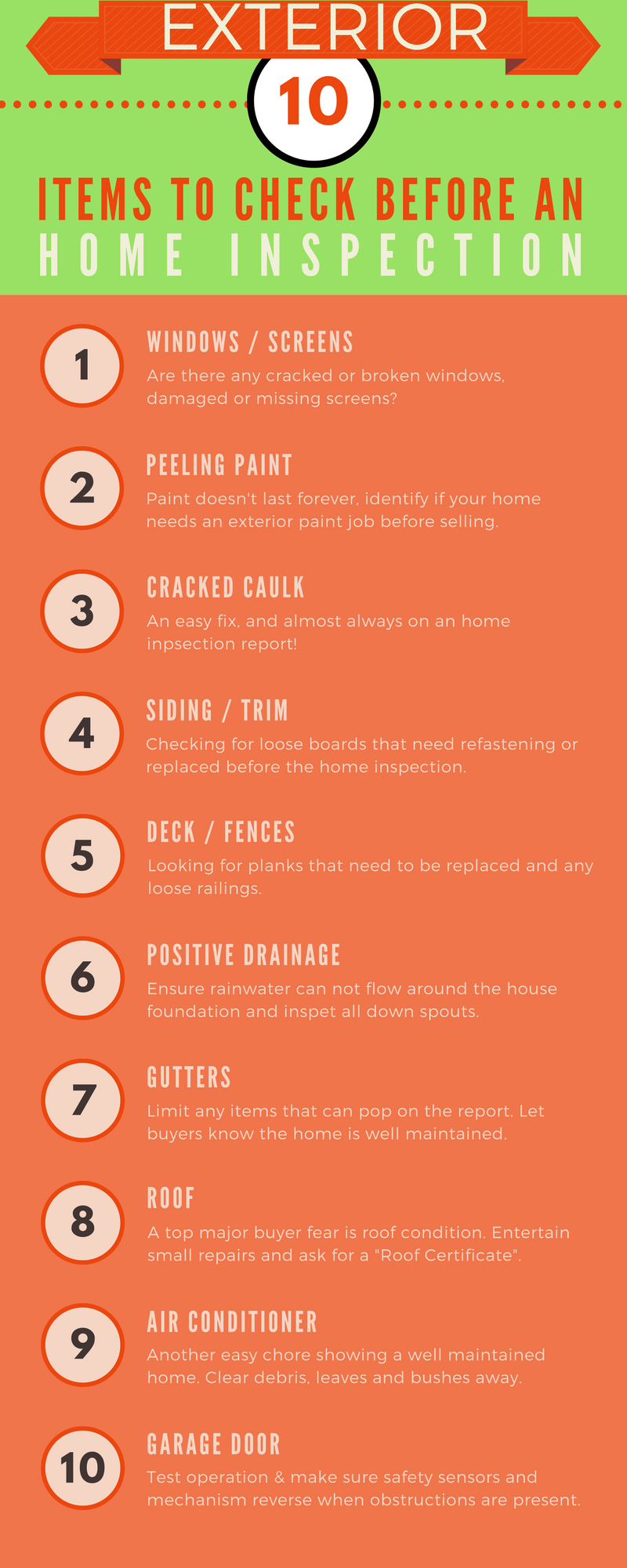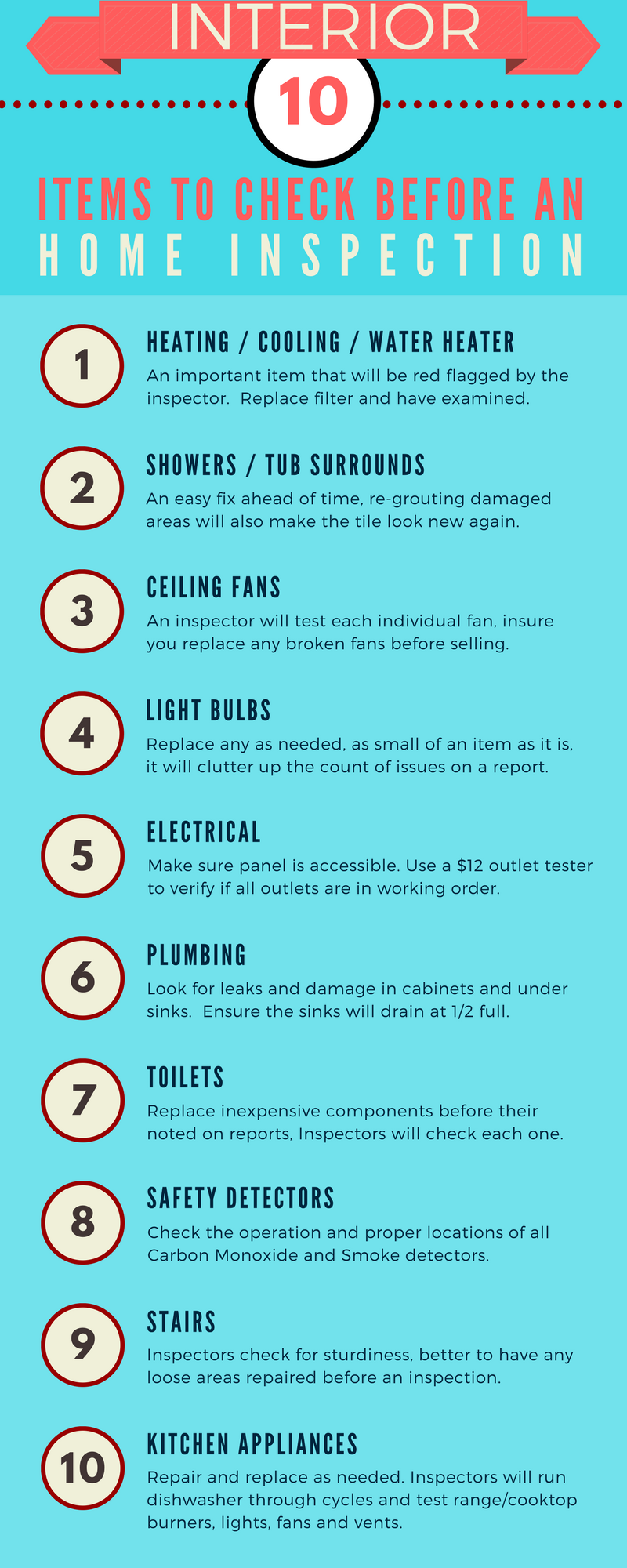How to Start Preparing for a Home Inspection
Preparing for a home inspection - It's like a scary dream! Envision you've been prepping your home to go up for sale for months. You worked with your REALTOR, a home staging expert and a contractor to make sure everything was perfect. Notably, so that you could sell your home for the most money possible and move on to your next home. The next thing you know, you get a great offer!
With excitement, you begin thinking about the money that you will make off of your home sale and start searching for your new home. Then, a call comes from your REALTOR, they tell you about the 6 major items that the home inspector found while viewing your property.
The buyers want all these items fixed before they will follow through and buy your home.

The deal is dead otherwise! Again, this scenario happens all too often in real estate.
However! This situation you can easily be avoided. Personally do a full home inspection to make sure that you are aware of any potential red flags that can come up on an inspection report. Don't get caught off guard by your buyer's repair requests. Additionally, hire a home inspector to check out these items for you.
Here's a list of the top 20 things to check when preparing for a home inspection


BREAKING DOWN
ALL 20 ITEMS!
eXTERIOR
Windows & Screens
1.) Repair or replace, if budget allows, any cracked or broken windows and damaged or missing screens. They will be written up in any credible inspection report. Any double glass panels that are “foggy” from broken seals will probably be noted as well.
Deteriorating Paint
2.) Paint doesn't last forever, identify if your home needs a new exterior paint job before you sell. Cracked, chipping, and bubbling paint on the exterior of the home are areas where moisture will build up.
Caulking & Sealing
3.) Caulking seals a home from extreme weather conditions and is a vital part of keeping heating and cooling costs lower. For this reason, home inspectors typically look for cracked caulking around doors, windows, and water areas. An easy fix! Simply purchase some high-grade caulking that fits what you sealing and repair as needed before the inspection appointment.
Siding & Exterior Trim
4.) Examine the exterior for any loose siding boards that may need to be tightened down or replaced. If you decided to replace siding, it's important to make sure and match the original color and textures to leave a consistent look.
Decks & Fences
5.) Check for frame of your fencing for loose boards and re secure them in place. If any railings or boards need repair or replaced, it's a good time to do that as well.
Proper Drainage
6.) Make sure your home has proper drainage. Ensure their are not direct routes where water can flow towards the house. Water should flow away from the home at least 3 feet. A little shovel work landscaping water away from the home is all that may be needed. Extend any gutter downspouts to empty 3’ away from the house or into a tray that does the same.
Gutters
7.) Clean out gutters to avoid them ending up on the home inspection report. Especially important if you own a two-story home where gutters can be seen by buyers from upper windows. Buyers will feel that the home has been well maintained having small chores like gutter cleaning completed. One of the easier checklist items to knock out.
Roofing
8.) A bad home inspection report can be a buyers worst fear. You will be better served by being proactive. Your agent can refer a roofer to come out and give you an estimate on minor repairs or patches. Doing this will help put the buyers at ease and certainly increase value in your home.
Exterior Air Conditioner
9.) Be sure the outside a/c unit is free of leaves, bushes, and grass clippings to allow proper cooling.
Garage Doors
10.) Do a garage door test by opening the door and having someone hit the button for you. While door is closing wave your foot in the path of the infrared beam near the bottom of the track. The door should immediately stop and reverse back to open position. Additionally, repeat this test but this time grab the door with both hands and make it stop. The garage door should offer a little resistance then reverse back to open position. The inspector will most likely perform both of these tests.
INTERIOR
HVAC & Water Heater
11.) Your agent can help you find a licensed contractor to make repairs or changes to your HVAC systems and water heater. Home inspectors turn on both of these systems to note if they are operational or not. Always replace your furnace's filter, takes seconds to do and can make a world of difference.
Bathrooms
12.) Showers, tubs and surrounds will often get written up for any cracks in the grout, or caulked joints. Another easily fix if you're a handy person. Match the grout color and texture and re-grout any damaged areas and make your tile look brand new again.
Ceiling Fans
13.) Home inspectors will test every ceiling fan in your home and verify they all work properly. Be sure to replace broken fans before listing your home for sale.
Light Bulbs
14.) Replace any light bulbs that are burnt out or broken. All interior and exterior lights will be checked. (light fixtures specifically, not lamps that are personal property).
Electrical
15.) Get a $10 outlet tester at any home improvement store. Find any outlets that will fail the inspector's test (yup! inspectors test every single indoor and outdoor outlet). Some testers even have a button to check GFI (ground fault interrupter) outlets. GFI outlets are usually located in areas that have water access. Updated building codes, for this reason, garages, exteriors, bathrooms, kitchens, and laundry areas may need or have these protections. Depending upon the year your home was built, you may have GFCI (ground fault circuit interrupter), outlets or a circuit breaker located in you main electrical panel.
Ensure your electrical panel is easily accessible. Switches, outlets and junction boxes must have cover plates and without any cracks. There can be no exposed “Romex” (home in-wall wire). It must be in a metal or plastic conduit.
Plumbing
16.) Check plumbing by filling plugging all sinks halfway then pulling plug to check normal draining. Clean the P-Trap if your sink drains too slowly. Check inside all sink cabinets for any moisture on the bottom, water lines and valves by wiping with a dry paper towel.
Toilets
17.) Flush all toilets as the functions of each one will be in the report. A leaking sound before flushing, is probably a flapper valve. Easily replaced fo $5-15 dollars and can be installed without tools. Don't forget to check if toilets move around and that they are properly mounted.
Safety Detectors
18.) Check all Carbon Monoxide detectors are installed in or near all sleeping areas of the home. One CO2 detector is required per level of the house. Smoke detectors are required inside every bedroom, in the hallways leading to bedrooms, as well as at least one on every level. Replace all batteries and push the test button for proper working order.
Stairs
19.) The balustrade (complete stair baluster system) will be checked for sturdiness. If any of it is loose, you might want to have that repaired before inspection.
Appliances
20.) Inspectors will run the kitchen appliances during inspection. Thus running of the dishwasher through its cycles, turning on all range and cook top burners, ovens, and vent fan & light. Be sure to check all functions of the refrigerator and consider repairing or replacing any appliances as needed.
BONUS:
hERE'S A FEW EXTRA ITEMS TO BE AWARE OF
Radon, Mold, Meth, etc.. are several available tests beyond the home inspection that buyers may have performed. In the Treasure Valley Idaho area, radon tests are very common, while the other two are rarely requested.
All your homes windows will be opened, closed and re-locked. Any windows that are hard to move or fail to lock will be noted on a home inspection report. Cleaning the tracks and guides can drastically improve operation as well as using a clear spray silicone from your local hardware store.
Home inspectors note each of the room for things like moisture staining, drywall cracks, loosened flooring, or uneven floor slopes.
Feel like these task lists are a bit too scary to take on? Don't panic! We recommend hiring your own home inspector to check everything for you. Having a home inspection before selling can cut down on any surprises you may get during the inspection contingency period. You may even be able to recoup some of the money spent on inspections by offering to sell the reports to buyers for a discounted price.
Check out the 7 Deadly Sins to Overpricing Your Home!


